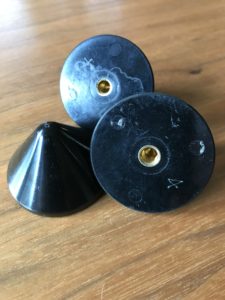
A week ago a friend loaned me a set of 3 BDR or Black Diamond Racing Pyramid Cones to try out. If you’re not familiar with the product, these are cone shaped feet for placing under your gear to improve isolation and control vibration. BDR Cones come in two different versions, the MK3 and the MK4. The MK3 is designed to warm up tonal balance and increase bottom end. The MK4 is designed for improving detail and top end extension. The “3”‘s and “4”‘s can apparently be mixed and matched to dial in the sound to ones tastes. The set I borrowed are the MK4.
When I upgraded my amp and pre a couple of years ago the shop gave me 2 sets of Ayre Myrtle Blocks to go with my new (used) Conrad Johnson ET3 and LP70S. From day one I had both units sitting on the Ayre blocks and it honestly never occurred to me to see how they sounded without the blocks. In fact, I have yet to do this, and will post a follow up to this when I get a couple of free hours to get my system humming and tune in my ears.
I had squandered an entire weekend of intensive listening before I realized the following Tuesday afternoon that I’d completely forgotten to try out the BDR Cones! I checked the clock and saw I had about an hour to warm up the system and sit down for a listening session. I did so and decided I’d do my best to give the cones a serious listen to see what they had to offer before I had to return them to their owner.
I first tried them under the ET3 and, initially, they did seem to tighten up the bass in a nice way. But within a minute or two I realized that this “tightening up” was actually across all frequencies and it was at the expense of space and resolution. With the BDR cones under the ET3 the sound was noticeably less open, had much less bass definition and sounded significantly rolled off at the high end. When I removed the cones and replaced them with the Ayre blocks, these qualities were restored.
Next I tried them under the LP70S. It’s by no means the heaviest amplifier out there, but it weighs enough to make swapping the cones for the blocks and back again a challenge. I persevered and was rewarded with essentially the same experience. Compared to the blocks, the cones robbed my system of a substantial amount of the open, spacious quality that audiophile vinyl enthusiasts like myself enjoy so much.
The loss of this open, spacious quality essentially amounts to a loss of transparency. This means that the extent to which this loss occurs will be directly proportional to the degree to which this quality is conveyed on a record. If I tested the cones on a record without a lot of transparency, the impact of the cones vs. the blocks would be minimal. But with a record that is fairly or perhaps even very transparent, the impact of the cones is substantial.
I realize now that I need to hear my CJ gear without the blocks and see how they perform that way, and then compare that performance, assuming it’s diminished, to the performance with the cones. My friend has agreed to let me keep the cones a bit longer to get this done, but so far other commitments have interfered. When it is done I will post the results.
No doubt each of these after market “feet” will affect the performance of different equipment differently, and therefore I want to make clear that I’m not generalizing here as to how the blocks or the cones will perform under different gear. I will say that I’d expect the blocks to generally complement other tube gear in a way similar to how they’ve complemented mine. Beyond that I have no idea.
But with the price of a set of Ayre Myrtle Blocks less than a lunch for 2 at a decent restaurant, I’d say it’s worth trying them out, especially if you’re currently using BDR Pyramid Cones. Just make sure you demo them with a great sounding record!